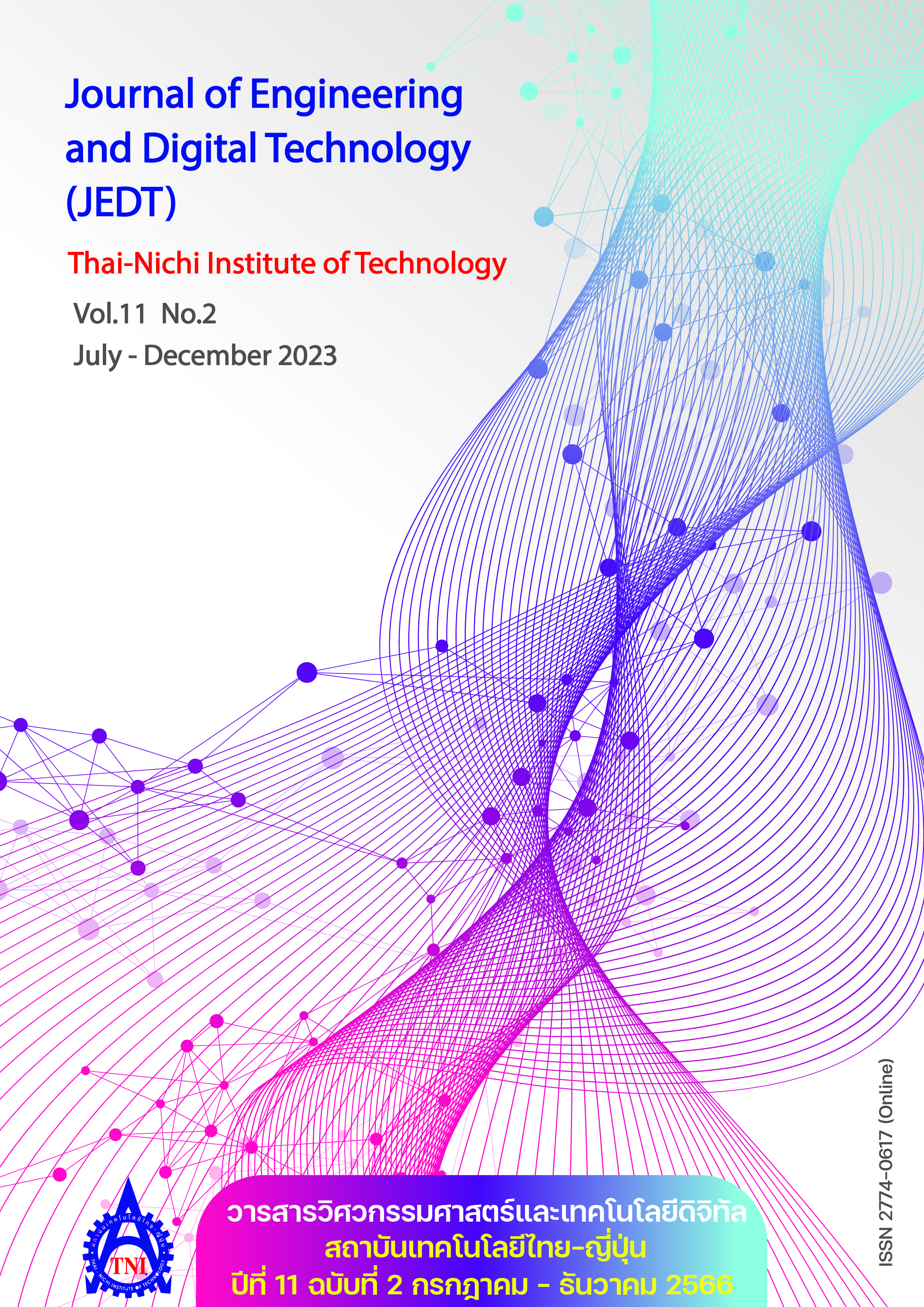แบบจำลองการพยากรณ์ปริมาณฝุ่นละออง PM2.5 ของจังหวัดพะเยา
Main Article Content
บทคัดย่อ
ฝุ่นละอองในบรรยากาศขนาดเล็กไม่เกิน 2.5 ไมครอน (PM2.5) เป็นปัญหามลพิษทางอากาศที่สำคัญในพื้นที่ภาคเหนือตอนบนของประเทศไทยซึ่งส่งผลกระทบต่อสุขภาพของประชาชนทั้งทางตรงและทางอ้อม โดยจังหวัดพะเยามีมลภาวะนี้จัดอยู่ 3 ลำดับแรกของภาคเหนือ การพยากรณ์ระดับความเข้มข้นของปริมาณฝุ่นละอองในบรรยากาศขนาดเล็กไม่เกิน 2.5 ไมครอน โดยใช้แบบจำลองทางคณิตศาสตร์ เป็นทางเลือกหนึ่งที่สามารถนำไปใช้ประกอบเป็นแนวทางในการวางแผนการแก้ไขหรือป้องกันปัญหามลพิษอากาศ การสร้างแบบจำลองการพยากรณ์ด้วยการประยุกต์ใช้วิธีการวิเคราะห์การถดถอยโลจิสติก โดยใช้ชุดข้อมูลจากกรมควบคุมมลพิษอากาศ และกรมอุตุนิยมวิทยาที่ตรวจวัดสภาพอากาศในจังหวัดพะเยา ซึ่งนำข้อมูลสถิติย้อนหลัง 5 ปี ในช่วงปี พ.ศ. 2558–2564 ไปสร้างแบบจำลองการพยากรณ์ด้วยโปรแกรมภาษาไพทอน ผลการทดสอบ พบว่า ตัวแปรอิสระที่นำไปสร้างสมการจำลองทางคณิตศาสตร์ สำหรับการพยากรณ์ค่า PM2.5 ของงานวิจัยนี้ ได้แก่ ค่า PM10, NO2, O3 และ CO เมื่อนำมาตรวจสอบความถูกต้องของแบบจำลองการพยากรณ์ โดยให้ค่าความไวและค่าความจำเพาะเท่ากับ 0.96 และ 0.72 ตามลำดับ โดยมีค่าพื้นที่ใต้เส้นโค้งเท่ากับ 0.98
Article Details

This work is licensed under a Creative Commons Attribution-NonCommercial-NoDerivatives 4.0 International License.
นโยบายการรับบทความ
กองบรรณาธิการวารสารสถาบันเทคโนโลยีไทย-ญี่ปุ่น มีความยินดีรับบทความจากอาจารย์ประจำ และผู้ทรงคุณวุฒิในสาขาวิศวกรรมศาสตร์และเทคโนโลยี ที่เขียนเป็นภาษาไทยหรือภาษาอังกฤษ ซึ่งผลงานวิชาการที่ส่งมาขอตีพิมพ์ต้องไม่เคยเผยแพร่ในสิ่งพิมพ์อื่นใดมาก่อน และต้องไม่อยู่ในระหว่างการพิจารณาของวารสารอื่นที่นำส่ง ดังนั้นผู้สนใจที่จะร่วมเผยแพร่ผลงานและความรู้ที่ศึกษามาสามารถนำส่งบทความได้ที่กองบรรณาธิการเพื่อเสนอต่อคณะกรรมการกลั่นกรองบทความพิจารณาจัดพิมพ์ในวารสารต่อไป ทั้งนี้บทความที่สามารถเผยแพร่ได้ประกอบด้วยบทความวิจัย ผู้สนใจสามารถศึกษาและจัดเตรียมบทความจากคำแนะนำสำหรับผู้เขียนบทความ
การละเมิดลิขสิทธิ์ถือเป็นความรับผิดชอบของผู้ส่งบทความโดยตรง บทความที่ได้รับการตีพิมพ์ต้องผ่านการพิจารณากลั่นกรองคุณภาพจากผู้ทรงคุณวุฒิและได้รับความเห็นชอบจากกองบรรณาธิการ
ข้อความที่ปรากฏภายในบทความของแต่ละบทความที่ตีพิมพ์ในวารสารวิชาการเล่มนี้ เป็น ความคิดเห็นส่วนตัวของผู้เขียนแต่ละท่าน ไม่เกี่ยวข้องกับสถาบันเทคโนโลยีไทย-ญี่ปุ่น และคณาจารย์ท่านอื่น ๆ ในสถาบัน แต่อย่างใด ความรับผิดชอบด้านเนื้อหาและการตรวจร่างบทความแต่ละบทความเป็นของผู้เขียนแต่ละท่าน หากมีความผิดพลาดใด ๆ ผู้เขียนแต่ละท่านจะต้องรับผิดชอบบทความของตนเองแต่ผู้เดียว
กองบรรณาธิการขอสงวนสิทธิ์มิให้นำเนื้อหา ทัศนะ หรือข้อคิดเห็นใด ๆ ของบทความในวารสารสถาบันเทคโนโลยีไทย-ญี่ปุ่น ไปเผยแพร่ก่อนได้รับอนุญาตจากผู้นิพนธ์ อย่างเป็นลายลักษณ์อักษร ผลงานที่ได้รับการตีพิมพ์ถือเป็นลิขสิทธิ์ของวารสารสถาบันเทคโนโลยีไทย-ญี่ปุ่น
ผู้ประสงค์จะส่งบทความเพื่อตีพิมพ์ในวารสารวิชาการ สถาบันเทคโนโลยีไทย-ญี่ปุ่น สามารถส่ง Online ที่ https://www.tci-thaijo.org/index.php/TNIJournal/ โปรดสมัครสมาชิก (Register) โดยกรอกรายละเอียดให้ครบถ้วนหากต้องการสอบถามข้อมูลเพิ่มเติมที่
- กองบรรณาธิการ วารสารสถาบันเทคโนโลยีไทย-ญี่ปุ่น
- ฝ่ายวิจัยและนวัตกรรม สถาบันเทคโนโลยีไทย-ญี่ปุ่น
เลขที่ 1771/1 สถาบันเทคโนโลยีไทย-ญี่ปุ่น ซอยพัฒนาการ 37-39 ถนนพัฒนาการ แขวงสวนหลวง เขตสวนหลวง กรุงเทพมหานคร 10250 ติดต่อกับคุณพิมพ์รต พิพัฒนกุล (02) 763-2752 , คุณจุฑามาศ ประสพสันติ์ (02) 763-2600 Ext. 2402 Fax. (02) 763-2754 หรือ E-mail: JEDT@tni.ac.th
References
S. Pansripong, “Development of artificial neural network model and multiple regression models for prediction of PM10 concentrations in Bangkok and Nakhon Ratchasima municipality area,” (in Thai), M.S. thesis, Dept. Environ. Eng., Suranaree Univ. Technol., Nakhon Ratchasima, Thailand, 2007.
W. Simachaya. “Smog Pollution in the Northern: Problems and Solutions.” (in Thai), PCD.go.th. https://www.pcd.go.th/wp-content/uploads/2020/06/pcdnew-2020-06-05_07-33-31_040770.pdf (accessed Feb. 1, 2023).
S. Pimonsree and P. Arrin, “Situation of Particulate Matter in Ambient Air and Impacts on Healthy,” (in Thai), in Proc. Naresuan Res. Conf.: Sustain. Ways of Living Based on Sufficiency Economy, Phitsanulok, Thailand, Jul. 2010, pp. 670–681.
T. Rattanapong, “University of Phayao joins forces with RISC by MQDC to move forward with Fasai 2 to Phayao, expanding urban air purification towers for people in the region to further research towards understanding PM 2.5 dust in the northern region.” (in Thai), UP.ac.th. https://www.up.ac.th/th/NewsRead.aspx?itemID=23918 (accessed Jul. 2, 2021).
Greenpeace Thailand. “The different air quality measurement standards.” (in Thai), GREENPEACE.org. https://www.greenpeace.org/thailandexplore/protect/cleanair/air-standard/ (accessed Nov. 23, 2022).
K. Meksagul and A. Phantong, “The prediction model of climate in Phayao,” (in Thai), in Proc. Operations Res. Netw. (OR-net) Conf., Chiang Mai, Thailand, Feb. 2019, pp. 30–40.
U. Amornnimit, “Logistic regression: Choice of risk analysis,” (in Thai), Univ. Thai Chamber of Commerce J., vol. 23, no. 2, pp. 21–35, 2003.
V. Kovenko and V. Shevchuk. “Machine Learning with Python: Differences between classification and regression.” READTHEDOCS.io. https://machine-learning-and-data-science-with-python.readthedocs.io/en/latest/assignment1_sup_ml_cls.html (accessed July. 2, 2021).
K. Pearson, “Notes on the history of correlation,” Biometrika, vol. 13, no. 1, pp. 25–45, 1920.
B. Pommapun, “Techniques for data interpreting for using correlation and regression in research,” (in Thai), STOU Educ. J., vol. 11, no. 1, pp. 32–45, 2018.
S. Srithongchai, “A PM2.5 prediction model using LSTM neural network in Bangkok area,” (in Thai), J. Eng. Digit. Technol. (JEDT), vol. 10, no. 1, pp. 1–9, 2022.
R. Kladchuen and C. Sanrach, “An efficiency comparison of algorithms and feature selection methods to predict the learning achievement of vocational students,” (in Thai), Res. J. Rajamangala Univ. Technol. Thanyaburi, vol. 17, no. 1, pp. 1–10, 2018.
C. Pruekpramool, N. Jaroentaku, and S. Srisuttiyakorn, “Efficiency of Pearson, Spearman and Kendall’s correlation coefficients when data is non-normal distributed,” (in Thai), OJED, vol. 15, no. 2, 2020, Art. no. OJED1502040.
B. Srisa-ard, Basic Research, 10th ed. Bangkok, Thailand: SUWEERIVASARN (in Thai), 2017.
S. Zhai et al., “Fine particulate matter (PM2.5) trends in China, 2013–2018: separating contributions from anthropogenic emissions and meteorology,” Atmos. Chem. Phys., vol. 19, no. 16, pp. 11031–11041, Aug. 2019, doi: 10.5194/acp-19-11031-2019.
M. Lachatre et al., “The unintended consequence of SO2 and NO2 regulations over China: Increase of ammonia levels and impaction PM2.5 concentrations,” Atmos. Chem. Phys., vol. 19, no. 10, pp. 6701–6716, May 2019, doi: 10.5194/acp-19-6701-2019.

